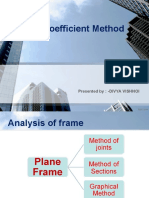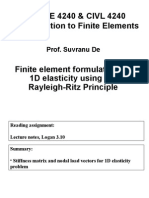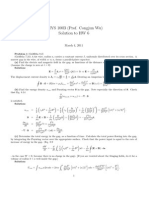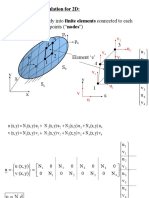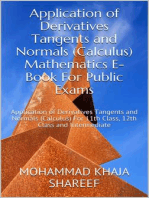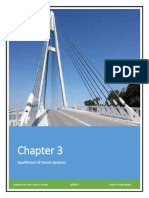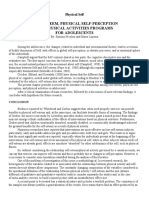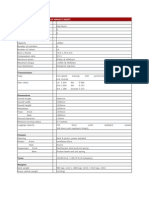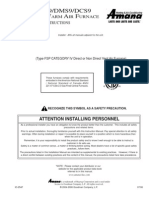Analysis of Structures: Prepared By: Engr. Lucia V. Ortega 8/28/20 Statics of Rigid Bodies
Uploaded by
Joren JamesAnalysis of Structures: Prepared By: Engr. Lucia V. Ortega 8/28/20 Statics of Rigid Bodies
Uploaded by
Joren JamesChapter 4
Analysis of Structures
Prepared by: Engr. Lucia V. Ortega 8/28/20 Statics of Rigid Bodies
Statics of Rigid Bodies Chapter 4: Analysis of Structures
Chapter Objectives
To develop the equations of equilibrium for a rigid body
To introduce the concept of the free-body diagram for a rigid body
To show how to solve rigid body equilibrium problems using the equations of equilibrium
Introduction
An engineering structure is any connected system of members built to support or transfer forces and to safely
withstand the loads applied to it. To determine the forces internal to an engineering structure, we must dismember
the structure and analyze separate free-body diagrams of individual members or combination of members. This
analysis requires careful application of Newton’s third law, which states that each action is accompanied by an equal
and opposite reaction.
Classifications of Structures
1. Truss – is a structure composed of members that are pin-connected and arranged in triangular manner to
constitute rigidity.
a) Plane trusses – the members of the truss lie essentially in a single plane. A simple truss requires three
members that are pin-connected at their ends.
b) Space trusses – consist of rigid links connected at their ends by ball-and-socket joints. It requires six bars
joined at their ends to form the edges of a tetrahedron as the basic noncollapsible unit.
2. Frame – are structures which are designed to support applied loads and are usually fixed in position
3. Machine – are structures that contains moving parts and are designed to transmit input forces or couples to
output forces or couples.
A frame or machine are a structure with at least one of its individual members is a multi-force member (also called
three-force member). A multi-force member is defined as one with three or more forces acting on it, or one with
two or more forces and one or more couples acting on it.
Prepared by: Engr. Lucia V. Ortega Page 1 of 20
Statics of Rigid Bodies Chapter 4: Analysis of Structures
Method of Joints
The method of joints may be summarized in the following steps:
1. Choose a pin (i.e., joint) on which no more than two members act. When the force in each member has been
determined, it is indicated on the truss diagram by arrows at each end of the member. These arrows act in the
direction appropriate for the force, i.e., toward the pin for compression and away from it for tension. When
force in a member is determined and appropriate arrows are marked on the original truss diagram, the member
is called marked member.
2. Draw the free-body diagram of the pin having only two unmarked members, assuming the forces in the
unmarked members to be either tension or compression. Solve the resulting equilibrium problem of
concurrent forces for the unknown forces. If a negative value is obtained for any force, the result will be correct
in magnitude, but opposite in action to that assumed.
Prepared by: Engr. Lucia V. Ortega Page 2 of 20
Statics of Rigid Bodies Chapter 4: Analysis of Structures
3. After determining the forces at a pin, mark the original truss diagram with appropriate arrows at each end of
the member whose force you have found. Remember that the arrows act away from the pins for tension and
toward them for compression.
4. From the original truss diagram, select the next pin at which there are only two unmarked members. Draw a
new free-body diagram and determine the forces. Continue this procedure until you have marked all the
members, thereby indicating that the internal forces in all members have been found.
5. In many cases it is preferable to work from one end of the truss to the middle member, and then from the
other end of the truss back toward the same mid-member. A check of the accuracy of the calculations is
obtained if the forces in the mid-member agree as determined with these two independent methods of
analysis.
Example 4.1
Calculate the force in each member of the loaded truss shown in the figure below. Tabulate the results and
indicate the nature, i.e., tension (T) or compression (C).
Solution: b) FBD of joint A
a) Solve for the reactions ∑ 𝐹𝑣 = 0 ↑ + ∑ 𝐹ℎ = 0 → +
1 1
∑ 𝑀𝐶 = 0 ↷ + 1 − 𝐴𝐸 ( ) = 0 𝐴𝐵 − √2 ( ) = 0
√2 √2
𝑅𝐴 (6) − 2(3) = 0 𝑅𝐴 = 1 𝑘𝑁 ↑ 𝐴𝐸 = √2 𝑘𝑁 (𝐶) 𝐴𝐵 = 1 𝑘𝑁 (𝑇)
∑ 𝐹𝑣 = 0 ↑ +
𝑅𝐴 − 𝑅𝐶𝑉 = 0 1 − 𝑅𝐶𝑉 = 0
𝑅𝐶𝑉 = 𝑅𝐴 = 1 𝑘𝑁 ↓
∑ 𝐹𝐻 = 0 → +
𝑅𝐶𝐻 − 2 = 0 𝑅𝐶𝐻 = 2 𝑘𝑁 →
c) FBD of Joint C d) FBD of Joint E
∑ 𝐹𝑣 = 0 ↑ + ∑ 𝐹ℎ = 0 → + ∑ 𝐹𝑣 = 0 ↑ + ∑ 𝐹ℎ = 0 → +
𝐶𝐷 − 1 = 0 2 − 𝐵𝐶 = 0 1 1
√2 (√2) − 𝐵𝐸 = 0 √2 (√2) − 𝐷𝐸 = 0
𝐶𝐷 = 1 𝑘𝑁 (𝑇) 𝐵𝐶 = 2 𝑘𝑁 (𝑇)
𝐵𝐸 = 1 𝑘𝑁 (𝑇) 𝐷𝐸 = 1 𝑘𝑁 (𝐶)
Prepared by: Engr. Lucia V. Ortega Page 3 of 20
Statics of Rigid Bodies Chapter 4: Analysis of Structures
e) FBD of Joint B f) Check using FBD of Joint D
∑ 𝐹𝑣 = 0 ↑ + ∑ 𝐹ℎ = 0 → + ∑ 𝐹𝑣 = 0 ↑ + ∑ 𝐹ℎ = 0 → +
1 1 1 1
1 − 𝐵𝐷 ( ) = 0 2 − √2 ( ) − 1 = 0 √2 (√2) − 1 = 0 1 + √2 ( ) − 2 = 0
√2 √2 √2
𝐵𝐷 = √2 𝑘𝑁 (𝐶) 0=0 ok! 0=0 ok! 0=0 ok!
Member Force (𝒌𝑵) Nature
AB 1 T
AE √2 C
BC 2 T
BD √2 C
BE 1 T
CD 1 T
DE 1 C
xxx
Example 4.2
Determine the force in each member of the loaded truss shown in the figure below. Make use of the symmetry
of the truss and of the loading. Tabulate the results and indicate the nature, i.e., tension (T) or compression (C).
Solution:
a) Solve for the reactions
Since the truss is symmetrical and symmetrically
loaded,
1
𝑅𝐴 = 𝑅𝐸 = (30 + 60 + 30) = 60 𝑘𝑁 ↑
2
b) FBD of joint A
∑ 𝐹𝑣 = 0 ↑ + ∑ 𝐹ℎ = 0 → +
4 5
30 − 𝐴𝐵 ( )=0 𝐴𝐻 − 𝐴𝐵 ( )=0
√41 √41
𝐴𝐵 = 48.023 𝑘𝑁 (𝐶) 𝐴𝐻 = 37.5 𝑘𝑁 (𝑇)
Prepared by: Engr. Lucia V. Ortega Page 4 of 20
Statics of Rigid Bodies Chapter 4: Analysis of Structures
c) FBD of Joint B d) FBD of Joint H
∑ 𝐹𝑣 = 0 ↑ + ∑ 𝐹ℎ = 0 → + ∑ 𝐹𝑣 = 0 ↑ + ∑ 𝐹ℎ = 0 → +
4 5 4
𝐴𝐵 ( ) − 𝐵𝐻 = 0 𝐴𝐵 ( ) − 𝐵𝐶 = 0 30 − 30 + 𝐶𝐻 ( )=0 𝐺𝐻 − 𝐴𝐻 = 0
√41 √41 √41
𝐵𝐻 = 30 𝑘𝑁 (𝑇) 𝐵𝐶 = 37.5 𝑘𝑁 (𝐶) 𝐶𝐻 = 0 𝐺𝐻 = 37.5 𝑘𝑁 (𝑇)
e) FBD of Joint G
∑ 𝐹𝑣 = 0 ↑ + ∑ 𝐹ℎ = 0 → + Answers:
𝐶𝐺 = 60 𝑘𝑁 (𝑇) 𝐹𝐺 = 37.5 𝑘𝑁 (𝑇) 𝑨𝑩 = 𝑫𝑬 = 𝟒𝟖. 𝟎𝟐𝟑 𝒌𝑵 (𝑪)
𝑨𝑯 = 𝑭𝑬 = 𝟑𝟕. 𝟓 𝒌𝑵 (𝑻)
𝑩𝑯 = 𝑫𝑭 = 𝟑𝟎 𝒌𝑵 (𝑻)
𝑩𝑪 = 𝑪𝑫 = 𝟑𝟕. 𝟓 𝒌𝑵 (𝑪)
𝑪𝑯 = 𝑪𝑭 = 𝟎
𝑮𝑯 = 𝑭𝑮 = 𝟑𝟕. 𝟓 𝒌𝑵 (𝑻)
𝑪𝑮 = 𝟔𝟎 𝒌𝑵 (𝑻)
Example 4.3
Determine the force in each member of the loaded truss. All triangles are equilateral.
Solution: b) FBD of joint A
a) Solve for the reactions ∑ 𝐹𝑣 = 0 ↑ +
Since all triangles are equilateral, it is also 𝑅𝐴𝑉 − 𝐴𝐸 sin 60° = 0
equiangular, that means all interior angles are 7.5 − 𝐴𝐸 sin 60° = 0
60°. Assume each member to be of unit length. 𝑨𝑬 = 𝟓√𝟑 𝒌𝑵 (𝑻)
∑ 𝑀𝐴 = 0 ↷ + ∑ 𝐹ℎ = 0 → +
1 3
8(1) + 4 ( ) + 2 ( ) − 𝑅𝐶 (2) cos 60° = 0 𝑅𝐴𝐻 + 𝐴𝐸 cos 60° − 𝐴𝐵 = 0
2 2 13√3
𝑹𝑪 = 𝟏𝟑 𝒌𝑵 + 5√3 cos 60° − 𝐴𝐵 = 0
2
∑ 𝐹𝑣 = 0 ↑ + 𝑨𝑩 = 𝟗√𝟑 𝒌𝑵 (𝑻)
𝑅𝐴𝑉 + 13 cos 60° − 8 − 4 − 2 = 0
𝑹𝑨𝑽 = 𝟕. 𝟓 𝒌𝑵
∑ 𝐹ℎ = 0 → + 𝑅𝐴𝐻 − 13 sin 60° = 0
𝟏𝟑√𝟑
𝑹𝑨𝑯 = = 𝟏𝟏. 𝟐𝟓𝟖 𝒌𝑵
𝟐
Prepared by: Engr. Lucia V. Ortega Page 5 of 20
Statics of Rigid Bodies Chapter 4: Analysis of Structures
c) FBD of Joint C 𝐵𝐶 − 13 sin 60° −
13√3
cos 60° = 0
3
∑ 𝐹𝑣 = 0 ↑ +
𝟐𝟔√𝟑
𝑩𝑪 = = 𝟏𝟓. 𝟎𝟏𝟏 𝒌𝑵 (𝑪)
𝑅𝐶 cos 60° − 𝐶𝐷 sin 60° = 0 𝟑
13 cos 60° − 𝐶𝐷 sin 60° = 0
𝟏𝟑√𝟑
𝑪𝑫 = = 𝟕. 𝟓𝟎𝟔 𝒌𝑵 (𝑻)
𝟑
∑ 𝐹ℎ = 0 → +
𝐵𝐶 − 𝑅𝐶 sin 60° − 𝐶𝐷 cos 60° = 0
d) FBD of Joint E 𝐷𝐸 −
7√3
cos 60° − 5√3 cos 60° = 0
3
∑ 𝐹𝑣 = 0 ↑ +
𝟏𝟏√𝟑
𝐴𝐸 sin 60° − 𝐵𝐸 sin 60° − 4 = 0 𝑫𝑬 = = 𝟔. 𝟑𝟓𝟏 𝒌𝑵 (𝑻)
𝟑
5√3 sin 60° − 𝐵𝐸 sin 60° − 4 = 0
𝟕√𝟑
𝑩𝑬 = = 𝟒. 𝟎𝟒𝟏 𝒌𝑵 (𝑪)
𝟑
∑ 𝐹ℎ = 0 → +
𝐷𝐸 − 𝐵𝐸 cos 60° − 𝐴𝐸 cos 60° = 0
e) FBD of Joint D f) Check using FBD of Joint B
∑ 𝐹𝑣 = 0 ↑ + ∑ 𝐹𝑣 = 0 ↑ +
𝐶𝐷 sin 60° − 𝐵𝐷 sin 60° − 2 = 0 𝐵𝐸 sin 60° + 𝐵𝐷 sin 60° − 8 = 0
13√3 7√3
sin 60° − 𝐵𝐷 sin 60° − 2 = 0 sin 60° + 3√3 sin 60° − 8 = 0
3 3
𝑩𝑫 = 𝟑√𝟑 = 𝟓. 𝟏𝟗𝟔 𝒌𝑵 (𝑪) 𝟎 = 𝟎 ok!
∑ 𝐹ℎ = 0 → + ∑ 𝐹ℎ = 0 → +
𝐶𝐷 cos 60° + 𝐵𝐷 cos 60° − 𝐷𝐸 = 0 𝐴𝐵 + 𝐵𝐸 cos 60° − 𝐵𝐶 − 𝐵𝐷 cos 60° = 0
13√3 11√3 7√3 26√3
cos 60° + 3√3 cos 60° − =0 9√3 + cos 60° − − 3√3 cos 60° = 0
3 3 3 3
0=0 ok! 𝟎=𝟎 ok!
Method of Sections
The use or method of sections permits us to determine directly the force in almost any member instead of
proceeding to that member by a join-to-joint analysis. In the method of sections, a cutting plane is passed through
the entire truss, separating it into two parts without cutting more than three members.
The method of sections may be summarized in the following steps:
1. For a given truss configuration with the applied loadings, pass a cutting plane through the entire truss,
separating it into two parts without cutting more than three members. Each part constitute a non-concurrent
system of forces in equilibrium under the action of the known loads that act on each part and the unknown
forces (stresses) that the members of one part exert on the other.
Prepared by: Engr. Lucia V. Ortega Page 6 of 20
Statics of Rigid Bodies Chapter 4: Analysis of Structures
2. Since the unknowns in either system are the same, it is generally best to determine the unknowns from the
equations of equilibrium applied to the simpler system. The forces in the uncut members are internal to the
free bodies shown. Consequently, the forces in these members occur in equal opposite pairs at their joints and
hence cancel out of any calculation involving the entire free body.
3. Determine each unknown force independently of the other unknown by taking moment summation at the
intersection of the unknown forces to be eliminated from the moment summation. In some cases where taking
moment summation will not eliminate the other unknowns because there are parallel forces or the forces
intersect at infinity, consider taking summation of forces (vertical or horizontal) to solve at least one of the
unknown forces. Continue taking moment summation until all the unknown force in the cut members are
solved.
Example 4.4
Calculate the forces in members BC, BE and EF. Solve for each force from an equilibrium equation, which contains
that force as the only unknown.
Solution:
a) Pass a cutting plane through members BC, BE, b) To solve for BC, take summation of moment
and EF. Consider the right side of the section so about joint E (to eliminate BE and EF)
that there will be no need to solve for the ∑ 𝑴𝑬 = 𝟎 ↷ +
reactions at the supports. (See FBD of the right 14(3) − 𝐵𝐶(2) = 0
segment.) 𝑩𝑪 = 𝟐𝟏 𝒌𝑵 (𝑻) Answer
c) To solve for EF, take summation of moment d) Since only BE remains unknown, we can take
about joint B (to eliminate BC and BE) summation of moment anywhere on the FBD
∑ 𝑴𝑬 = 𝟎 ↷ + ∑ 𝑴𝑪 = 𝟎 ↷ +
1 3 28√10 3 3
14(6) − 𝐸𝐹 ( ) (3) − 𝐸𝐹 ( ) (2) = 0 14(3) − ( ) (2) + 𝐵𝐸 ( ) (2) = 0
√10 √10 3 √10 √13
𝟐𝟖√𝟏𝟎 𝟕√𝟏𝟑
𝑬𝑭 = = 𝟐𝟗. 𝟓𝟏𝟓 𝒌𝑵 (𝑪) Answer 𝑩𝑬 = = 𝟖. 𝟒𝟏𝟑 𝒌𝑵 (𝑻) Answer
𝟑 𝟑
Prepared by: Engr. Lucia V. Ortega Page 7 of 20
Statics of Rigid Bodies Chapter 4: Analysis of Structures
Example 4.5
The members CJ and CF of the loaded truss cross but are not connected to members BI and DG. Compute the
forces in members BC, CJ, CI, and HI.
Solution: d) Pass a section that will cut through BC, CI, CJ and
For this problem, we need to solve first for the HI and consider the left segment of the section
reactions at the support (at least at the left support).
∑ 𝑴𝑪 = 𝟎 ↷ +
Then we will solve for the unknown forces using the
𝑅𝐽 (6) − 6(6) sin 60° − 4(3) − 𝐻𝐼(4) = 0
combination of method of joints and method of
14.196 (6) − 6(6) sin 60° − 4(3) − 𝐻𝐼(4) = 0
sections.
𝑯𝑰 = 𝟏𝟎. 𝟓𝟎 𝒌𝑵 (𝑻) Answer
a) ∑ 𝑴𝑭 = 𝟎 ↷ + ∑ 𝑴𝑰 = 𝟎 ↷ +
𝑅𝐽 (12) + 6 (4)cos 60° − 6(12) sin 60° −
𝑅𝐽 (3) + 6(4) cos 60° − 6(3) sin 60° − 𝐵𝐶(4) −
4(9) − 10(6) − 8(3) = 0 2
𝑅𝐽 = 14.196 𝑘𝑁 ↑ 𝐶𝐼 ( ) (3) = 0
√3
b) Consider FBD of joint A 14.196(3) + 6(4) cos 60° − 6(3) sin 60° −
2
∑ 𝐹𝑣 = 0 ↑ + 𝐵𝐶(4) − 16.225 ( ) (3) = 0
√13
𝐴𝐽 − 6 sin 60° = 0 𝑩𝑪 = 𝟑. 𝟎 𝒌𝑵 (𝑪) Answer
𝐴𝐽 = 3√3 = 5.196 𝑘𝑁 (𝐶) ∑ 𝑴𝑨 = 𝟎 ↷ +
4
6(4) cos 60° + 4(3) − 𝐵𝐶(4) − 𝐶𝐻 ( ) (3) = 0
5
4
6(4) cos 60° + 4(3) − 3(4) − 𝐶𝐻 ( ) (3) = 0
5
𝑪𝑯 = 𝟓. 𝟎 𝒌𝑵 (𝑻) Answer
c) Consider FBD of joint J
∑ 𝐹𝑣 = 0 ↑ +
2
𝑅𝐽 − 𝐴𝐽 − 𝐶𝐽 ( )=0
√13
2
14.196 − 3√3 − 𝐶𝐽 ( )=0
√13
𝑪𝑱 = 𝟏𝟔. 𝟐𝟐𝟓 𝒌𝑵 (𝑪) Answer
Prepared by: Engr. Lucia V. Ortega Page 8 of 20
Statics of Rigid Bodies Chapter 4: Analysis of Structures
Example 4.6
Determine the forces in members GH and CG for the truss loaded and supported as shown. Does the statical
determinacy of the supports affect your calculations?
Solution:
Hinges at E and F support the truss in this problem; therefore,
there will be four reactions (horizontal and vertical reactions at
both E and F). For a plane truss, there are three available
equations of equilibrium for the solutions. For the truss in this
problem, there is one external redundant reactions. Therefore,
it is considered first degree statically indeterminate. However,
this problem can still be solve using method of section by
passing a cutting plane through members GH, CG and CD.
Consider the left side of the section.
a) ∑ 𝑀𝐶 = 0 ↷ +
50(8) − 𝐺𝐻(4) = 0
𝑮𝑯 = 𝟏𝟎𝟎 𝒌𝑵 (𝑻) Answer
b) ∑ 𝑀𝐴 = 0 ↷ +
1
100(4) − 𝐶𝐺 ( ) (8) = 0
√2
𝑮𝑯 = 𝟓𝟎√𝟐 𝒌𝑵 (𝑻) Answer
Space Truss
A space truss is the three-dimensional counterpart of the plane truss. The idealized space truss consists of rigid links
connected at their ends by ball-and-socket joints, which requires six bars joined at their ends to form the edges of a
tetrahedron as the basic noncollapsible unit.
Example 4.7
Determine the forces in members AB, AC, and AD.
Solution:
a) Coordinates of points
𝐴(0, 0, 6) 𝐵(−1, −3, 0) 𝐶(2, 0, 0) 𝐷(−1, 3, 0)
b) Length of Members
𝑑𝐴𝐵 = √(−1 − 0)2 + (−3 − 0)2 + (0 − 6)2 = √46
𝑑𝐴𝐶 = √(2 − 0)2 + (0 − 0)2 + (0 − 6)2 = √40
𝑑𝐴𝐷 = √(−1 − 0)2 + (3 − 0)2 + (0 − 6)2 = √46
c) Components of AB, AC, and AD
𝐴𝐵 𝐴𝐵𝑥 𝐴𝐵𝑦 𝐴𝐵𝑧
= = =
√46 1 3 6
𝐴𝐶 𝐴𝐶𝑥 𝐴𝐶𝑧
= =
√40 2 6
𝐴𝐷 𝐴𝐷𝑥 𝐴𝐷𝑦 𝐴𝐷𝑧
= = =
√46 1 3 6
Prepared by: Engr. Lucia V. Ortega Page 9 of 20
Statics of Rigid Bodies Chapter 4: Analysis of Structures
d) Equilibrium equations
∑ 𝐹𝑥 = 0 → +
𝐴𝐵𝑥 − 𝐴𝐶𝑥 − 𝐴𝐷𝑥 = 0
1 2 1
𝐴𝐵 − 𝐴𝐶 − 𝐴𝐷 = 0 eq. 1
√46 √40 √46
∑ 𝐹𝑦 = 0 → +
𝐴𝐵𝑦 + 𝐴𝐷𝑦 − 5 sin 30° = 0
3 3
𝐴𝐵 + 𝐴𝐷 = 2.5 eq. 2
√46 √46
∑ 𝐹𝑧 = 0 ↑ +
𝐴𝐵𝑧 + 𝐴𝐶𝑧 − 𝐴𝐷𝑧 − 5 cos 30° = 0
6 6 6
𝐴𝐵 + 𝐴𝐶 − 𝐴𝐷 = 5 cos 30° eq. 3
√46 √40 √46
e) Solving equations 1, 2, and 3 simultaneously
𝑨𝑩 = 𝟒. 𝟒𝟓𝟖 𝒌𝑵 (𝑪) Answer
𝑨𝑪 = 𝟏. 𝟓𝟐𝟏 𝒌𝑵 (𝑪) Answer
𝑨𝑫 = 𝟏. 𝟏𝟗𝟒 𝒌𝑵 (𝑻) Answer
Example 4.8
The tetrahedral space truss has a horizontal base ABC in the form of an isosceles triangle and legs AD, BD, and CD
that support the mass m from point D. A vertical wire from overhead supports suspends each vertex of the base.
Calculate the forces induced in members AC and AB
Solution:
a) From truss as a whole, ∑ 𝑀𝑦 = 0 gives tension in vertical
wire at C
∑ 𝑀𝑦 = 0 ↷ +
𝑚𝑔(1) − 𝑇𝐶 (3) = 0
1
𝑇𝐶 = 𝑚𝑔
3
1
b) By symmetry, ∑ 𝐹𝑧 = 0; 𝑇𝐴 = 𝑇𝐵 = 𝑚𝑔
3
c) Consider FBD of joint A
Coordinates of A, B, C, and D
𝐴(−1, −4, 0) 𝐵(−1, 4, 0) 𝐶(2, 0, 0)
𝐷(0, 0, 6)
Length of Members
𝑑𝐴𝐵 = √(0)2 + (8)2 + (0)2 = 8
𝑑𝐴𝐶 = √(2 + 1)2 + (0 + 4)2 + (0)2 = 5
𝑑𝐴𝐷 = √(0 + 1)2 + (0 + 4)2 + (6 − 0)2 = √53
Components of AB, AC, and AD
𝐴𝐵 𝐴𝐵𝑦
=
8 8
𝐴𝐶 𝐴𝐶𝑥 𝐴𝐶𝑦
= =
5 3 4
𝐴𝐷 𝐴𝐷𝑥 𝐴𝐷𝑦 𝐴𝐷𝑧
= = =
√53 1 4 6
Prepared by: Engr. Lucia V. Ortega Page 10 of 20
Statics of Rigid Bodies Chapter 4: Analysis of Structures
Equilibrium equations
∑ 𝐹𝑥 = 0 → + −𝐴𝐶𝑥 + 𝐴𝐷𝑥 = 0
3 1
− 𝐴𝐶 + 𝐴𝐷 = 0 eq. 1
5 √53
∑ 𝐹𝑦 = 0 → + 𝐴𝐵𝑦 − 𝐴𝐶𝑦 + 𝐴𝐷𝑦 = 0
4 4
−𝐴𝐵 − 𝐴𝐶 + 𝐴𝐷 = 0 eq. 2
5 √53
∑ 𝐹𝑧 = 0 ↑ + 𝑇𝐴 − 𝐴𝐷𝑧 = 0
1 6 √53
𝑚𝑔 − 𝐴𝐷 = 0 𝐴𝐷 = 𝑚𝑔
3 √53 18
Substitute AD to eq. 1
5
𝐴𝐶 = 𝑚𝑔
54
Substitute AD and AC to eq. 2
4
𝐴𝐵 = 𝑚𝑔
27
Answers:
√𝟓𝟑 𝟓 𝟒
𝑨𝑫 = 𝒎𝒈 (𝑻) ; 𝑨𝑪 = 𝒎𝒈 (𝑪) ; 𝑨𝑩 = 𝒎𝒈 (𝑪)
𝟏𝟖 𝟓𝟒 𝟐𝟕
Redundant Members; Counter Diagonals
In trusses subjected to moving loads, such as railroad bridges, the diagonal members may undergo reversal of stress;
that is, a diagonal normally in tension may become subject to a compressive load. If the diagonal is composed of
eyebars or is otherwise so slender compared with its length that it will buckle under compressive loads, an additional
diagonal sloping in the opposite direction must be provided in the truss panel to prevent collapse of the structure.
These diagonals are usually known as counter diagonals, or more briefly, counters. In considering the action of
counter, it is convenient to regard them as wires, which can support tension but will buckle instantly if subjected to
compression.
Example 4.9
The truss shown is composed of 45 right triangles. The crossed members in the center two panels are slender tie
rods incapable of supporting compression. Retain the two rods, which are under tension and compute the
magnitudes of their tensions. Also, find the force in member MN.
Solution:
Since all triangles are 45, the legs of the triangles are of equal
length. We can assume the legs of the triangles be of unit length.
a) Solve for reactions at each supports
∑ 𝑀𝐴 = 0 ↷ +
100(4) − 80(2) − 𝑅𝐵 (6) = 0
𝑅𝐵 = 60 𝑘𝑁 ↑
∑ 𝐹𝑣 = 0 ↑ + 𝑅𝐴𝑉 + 60 − 100 = 0
𝑅𝐴𝑉 = 40 𝑘𝑁 ↑
∑ 𝐹ℎ = 0 → + 𝑅𝐴𝐻 − 80 = 0
𝑅𝐴𝐻 = 80 𝑘𝑁 →
Prepared by: Engr. Lucia V. Ortega Page 11 of 20
Statics of Rigid Bodies Chapter 4: Analysis of Structures
b) Pass a cutting plane through members EF, FN, EM and MN.
Consider the right segment. Member EM is under
compression; hence, we can consider it zero-force
member.
∑ 𝑀𝐹 = 0 ↷ +
100(1) − 60(3) + 𝑀𝑁(1) = 0
𝑴𝑵 = 𝟖𝟎 𝒌𝑵 (𝑻)
∑ 𝑀𝐸 = 0 ↷ +
80(1) − 60(2) + 𝐹𝑁(1) cos 45° = 0
𝑭𝑵 = 𝟒𝟎√𝟐 𝒌𝑵 (𝑻)
c) Pass a cutting plane through members FG, FL, GM and LM.
Consider the right segment. Member FL is subjected to
compressive force; hence, we can consider it zero-force
member.
∑ 𝑀𝐺 = 0 ↷ +
100(2) − 60(4) + 𝐿𝑀(1) = 0
𝐿𝑀 = 40 𝑘𝑁(𝑇)
∑ 𝑀𝐹 = 0 ↷ +
40(1) + 100(1) − 60(3) + 𝐺𝑀(1) cos 45° = 0
𝑮𝑴 = 𝟒𝟎√𝟐 𝒌𝑵 (𝑻)
Example 4.10
The center panel of the truss shown in the figure contains two flexible cables. What load P will cause a
compressive force of 2000 𝑙𝑏 in BD? Then determine which tension diagonal BE or CD is acting and the force in
it.
Solution:
a) Solve for the reactions at each support.
∑ 𝑀𝐹 = 0 ↷ + 𝑅𝐴 (3𝐿) − 𝑃(2𝐿) = 0
𝟐
𝑹𝑨 = 𝑷
𝟑
∑ 𝐹𝑉 = 0 ↑ + 𝑅𝐴 + 𝑅𝐹 − 𝑃 = 0
2 𝟏
𝑃 + 𝑅𝐹 − 𝑃 = 0 𝑹𝑭 = 𝑷
3 𝟑
b) Pass a cutting plane through members BD, BE, CD and CE.
Consider FBD of the left segment. Member BE is under
compression; hence, we can consider it zero-force member.
∑ 𝑀𝐶 = 0 ↷ + 𝑅𝐴 (𝐿) − 𝐵𝐷(𝐿) = 0
2
𝑃 (𝐿) − 2000(𝐿) = 0 𝑷 = 𝟑𝟎𝟎𝟎 𝒍𝒃
3
∑ 𝑀𝐴 = 0 ↷ +
1
3000(𝐿) − 2000(𝐿) − 𝑇𝐶𝐷 ( ) (𝐿) = 0
√2
𝑻𝑪𝑫 = 𝟏𝟎𝟎𝟎√𝟐 = 𝟏𝟒𝟏𝟒. 𝟐𝟏𝟒 𝒍𝒃
Prepared by: Engr. Lucia V. Ortega Page 12 of 20
Statics of Rigid Bodies Chapter 4: Analysis of Structures
Example 4.11
The center diagonals of the truss in the figure can support tension only. Compute the force in each center diagonal
and the force in BC, DE, and FG.
Solution:
a) Solve for reactions at each support
∑ 𝑀𝐻 = 0 ↷ +
𝑅𝐶 (50) − 200(70) − 600(30) − 600(15) − 300(20) = 0
𝑅𝐶 = 940 𝑙𝑏
∑ 𝐹𝑣 = 0 ↑ +
940 + 𝑅𝐻𝑉 − 200 − 600 − 600 = 0
𝑅𝐻𝑉 = 460 𝑙𝑏
∑ 𝐹𝐻 = 0 → +
𝑅𝐻𝐻 − 300 = 0 𝑅𝐻𝐻 = 300 𝑙𝑏
b) Pass a cutting plane through members BD, BE, CD and CE.
Force in member 𝑪𝑫 = 𝟎
∑ 𝑀𝐸 = 0 ↷ +
𝐵𝐷(20) − 300(20) − 𝑅𝐻𝑉 (30) + 600(15) = 0
𝐵𝐷(20) − 300(20) − 460(30) + 600(15) = 0
𝐵𝐷 = 540 𝑙𝑏 (𝐶)
∑ 𝑀𝐻 = 0 ↷ +
𝐵𝐷(20) − 600(30) − 600(15) − 300(20) +
1
𝐵𝐸 ( ) (30) = 0
√2
540(20) − 600(30) − 600(15) − 300(20) +
1
𝐵𝐸 ( ) (30) = 0 d) Consider FBD of joint C
√2
𝑩𝑬 = 𝟏𝟎𝟒𝟔. 𝟓𝟏𝟖 𝒍𝒃 (𝑻) ∑ 𝐹𝑉 = 0 ↑ + 𝐵𝐶 − 𝑅𝐶 = 0
c) Pass a cutting plane through members DF, EF, DG and EG. 𝑩𝑪 = 𝟗𝟒𝟎 𝒍𝒃 (𝑪)
Force in member 𝑬𝑭 = 𝟎 e) Consider FBD of joint E
∑ 𝑀𝐺 = 0 ↷ + ∑ 𝐹𝑉 = 0 ↑ +
1
𝐷𝐹(20) − 300(20) − 𝑅𝐻𝑉 (15) = 0 𝐵𝐸 ( ) − 𝐷𝐸 − 600 = 0
√2
𝐷𝐹(20) − 300(20) − 460(15) = 0 𝑫𝑬 = 𝟏𝟒𝟎 𝒍𝒃 (𝑪)
𝐷𝐹 = 645 𝑙𝑏 (𝐶) f) Consider FBD of joint G
∑ 𝑀𝐻 = 0 ↷ + ∑ 𝐹𝑉 = 0 ↑ +
4
𝐷𝐹(20) − 600(15) − 300(20) + 𝐷𝐺 ( ) (15) = 0 4
𝐷𝐺 ( ) + 𝐹𝐺 − 600 = 0
5
5
4
645(20) − 600(15) − 300(20) + 𝐷𝐺 ( ) (15) = 0 𝑭𝑮 = 𝟒𝟔𝟎 𝒍𝒃 (𝑪)
5
𝑫𝑮 = 𝟏𝟕𝟓 𝒍𝒃 (𝑻)
Prepared by: Engr. Lucia V. Ortega Page 13 of 20
Statics of Rigid Bodies Chapter 4: Analysis of Structures
Frames and Machines
A frame or a machine is a structure with at least one of its members is a multi-force member. A multi-force member
is defined as one with three or more forces acting on it. Frames are structures which are designed to support applied
loads and are usually fixed in position. Machines are structures which contain moving parts and are designed to
transmit input forces or couples to output forces or couples.
Example 4.12
For the frame loaded as shown in the figure, determine the horizontal and vertical components of the pin pressure
at B. Specify directions (up or down; left or right) of the force as it acts upon member CD.
Solution: c) Check your answers using FBD of member AB
a) Consider FBD of the whole frame ∑ 𝐹𝑣 = 0 ↑ +
∑ 𝑀𝐴 = 0 ↷ + 𝐵𝑉 − 𝑅𝐴𝑉 − 200 = 0
200(2) + 300(6) − 𝑅𝐷𝑉 (4) = 0 550 − 350 − 200 = 0
𝑅𝐷𝑉 = 550 𝑙𝑏 ↑ 0=0 ok!
∑ 𝐹𝑣 = 0 ↑ + ∑ 𝐹ℎ = 0 → +
𝑅𝐷𝑉 − 𝑅𝐴𝑉 − 200 = 0 𝐵𝐻 − 𝑅𝐴𝐻 = 0
550 − 𝑅𝐴𝑉 − 200 = 0 450 − 𝑅𝐴𝐻 = 0
𝑅𝐴𝑉 = 350 𝑙𝑏 ↓ 𝑅𝐴𝐻 = 450 𝑙𝑏 ←
b) Consider FBD of member CBD d) Consider FBD of the whole frame
∑ 𝑀𝐷 = 0 ↷ + ∑ 𝐹ℎ = 0 → +
300(6) − 𝐵𝐻 (4) = 0 𝑅𝐷𝐻 − 𝑅𝐴𝐻 = 0
𝑩𝑯 = 𝟒𝟓𝟎 𝒍𝒃 ← 450 − 450 = 0
∑ 𝐹𝑣 = 0 ↑ + 0=0 ok!
𝑅𝐷𝑉 − 𝐵𝑉 = 0
550 − 𝐵𝑉 = 0
𝑩𝑽 = 𝟓𝟓𝟎 𝒍𝒃 ↓
Prepared by: Engr. Lucia V. Ortega Page 14 of 20
Statics of Rigid Bodies Chapter 4: Analysis of Structures
Example 4.13
The frame shown in the figure is hinged to rigid supports at A and E. Find the components of the hinge forces at
A and E and the forces in members BC and BD.
Solution:
a) Consider FBD of the whole frame
∑ 𝑀𝐸 = 0 ↷ + 120(4) − 𝐴ℎ (4) = 0
𝑨𝒉 = 𝟏𝟐𝟎 𝒍𝒃 ←
∑ 𝐹𝐻 = 0 → + 𝐸ℎ − 𝐴ℎ = 0
𝐸ℎ − 120 = 0 𝑬𝒉 = 𝟏𝟐𝟎 𝒍𝒃 →
b) Consider FBD of member AB
3
∑ 𝐹𝐻 = 0 → + 𝐵𝐷 ( ) − 𝐴ℎ = 0
5
3
𝐵𝐷 ( ) − 120 = 0 𝐵𝐷 = 200 𝑙𝑏 ↗
5
∑ 𝑀𝐴 = 0 ↷ +
4
120(4) − 𝐵𝐷 ( ) (8) + 𝐵𝐶(8) = 0
5
4
120(4) − 200 ( ) (8) − 𝐵𝐶(8) = 0
5
𝐵𝐶 = 100 𝑙𝑏 ↓
4
∑ 𝐹𝑣 = 0 ↑ + 𝐴𝑉 + 𝐵𝐷 ( ) − 𝐵𝐶 = 0
5
4
𝐴𝑉 + 200 ( ) − 100 = 0 𝑨𝑽 = 𝟔𝟎 𝒍𝒃 ↑
5
c) Consider FBD of member CDE
4
∑ 𝐹𝑣 = 0 ↑ + 𝐸𝑉 − 𝐵𝐷 ( ) + 𝐵𝐶 = 0
5
4 ∑ 𝑀𝐸 = 0 ↷ +
𝐸𝑉 − 200 ( ) + 100 = 0 𝑬𝑽 = 𝟔𝟎 𝒍𝒃 ↑
5 4
𝐵𝐷 ( ) (5) − 𝐵𝐶(8) = 0
d) Check 4
3 4
∑ 𝐹𝐻 = 0 → + 𝐸ℎ − 𝐵𝐷 ( ) = 0 200 ( ) (5) − 100(8) = 0
5 4
3 𝟎=𝟎 ok!
120 − 200 ( ) = 0 𝟎=𝟎 ok!
5
Prepared by: Engr. Lucia V. Ortega Page 15 of 20
Statics of Rigid Bodies Chapter 4: Analysis of Structures
Example 4.14
A billboard BC weighing 1000 𝑙𝑏 is subjected to a wind pressure of 300 𝑙𝑏/𝑓𝑡 as shown in the figure. Neglecting
the weights of the supporting members, determine the components of the hinge forces at A and F.
Solution:
a) Consider FBD of member BC
3
∑ 𝑀𝐵 = 0 ↷ + 300(10)(5) − 𝑅𝐶 ( ) (10) = 0
√10
𝑅𝐶 = 500√10 𝑙𝑏
b) Consider FBD of member DEF
∑ 𝑀𝐹 = 0 ↷ +
3 3
500√10 ( ) (8) − 𝑅𝐸 ( ) (4) = 0
√10 √13
𝑅𝐸 = 1000√13 𝑙𝑏
∑ 𝐹𝐻 = 0 → +
3 3
500√10 ( ) − 1000√13 ( ) + 𝑅𝐹𝐻 = 0
√10 √13
𝑹𝑭𝑯 = 𝟏𝟓𝟎𝟎 𝒍𝒃 →
c) Consider FBD of member CD
𝑅𝐶 = 𝑅𝐷 = 500√10 𝑙𝑏
d) Consider FBD of the whole structure
∑ 𝐹𝐻 = 0 → + 300(10) + 𝑅𝐹𝐻 − 𝑅𝐴𝐻 = 0
300(10) + 1500 − 𝑅𝐴𝐻 = 0 𝑹𝑨𝑯 = 𝟒𝟓𝟎𝟎 𝒍𝒃 ←
∑ 𝑀𝐴 = 0 ↷ +
300(10)(9) + 1000(6) − 𝑅𝐹𝑉 (12) + 𝑅𝐹𝐻 (4) = 0
300(10)(9) + 1000(6) − 𝑅𝐹𝑉 (12) + 1500(4) = 0
𝑹𝑭𝑽 = 𝟑𝟐𝟓𝟎 𝒍𝒃 ↑
∑ 𝐹𝑉 = 0 ↑ + 𝑅𝐹𝑉 − 𝑅𝐴𝑉 − 1000 = 0
3250 − 𝑅𝐴𝑉 − 1000 = 0 𝑹𝑨𝑽 = 𝟐𝟐𝟓𝟎 𝒍𝒃 ↓
Prepared by: Engr. Lucia V. Ortega Page 16 of 20
Statics of Rigid Bodies Chapter 4: Analysis of Structures
Example 4.15
For an 80-N squeeze on the handles of the pliers, determine the force F applied to the round rod by each jaw. In
addition, calculate the force supported by the pin at A.
Solution:
a) ∑ 𝑀𝐴 = 0 ↷ +
80(95) − 𝐹(35) = 0
𝑭 = 𝟐𝟏𝟕. 𝟏𝟒𝟑 𝑵
b) ∑ 𝐹𝑣 = 0 ↑ +
𝐴 = 80 − 217.143 = 0
𝑨 = 𝟐𝟗𝟕. 𝟏𝟒𝟑 𝑵
Example 4.16
The automobile bumper jack is designed to support a 400 N downward load. Begin with a free-body diagram of
BCD and determine the force supported by roller C. Note that roller B does not contact the vertical column.
Solution:
∑ 𝑀𝐴 = 0 ↷ +
𝐶(340) − 4000(550) = 0
𝑪 = 𝟔𝟕𝟒𝟎. 𝟓𝟖𝟖 𝑵
Example 4.17
The device shown in the figure is designed to drive brads into picture-framing material. For a gripping force of 10
lb on the handles, determine the force F exerted on the brad.
Solution:
∑ 𝑀𝐴 = 0 ↷ +
10(2.5) − 𝐵𝑥 (1) = 0
𝐵𝑥 = 25 𝑙𝑏
The for F on the brad is 25 lb
Prepared by: Engr. Lucia V. Ortega Page 17 of 20
Statics of Rigid Bodies Chapter 4: Analysis of Structures
Example 4.18
Determine the magnitude of the pin reaction at A and the magnitude and direction of the force reaction at the
rollers. The pulleys at C and D are small.
Solution:
𝑚
a) 𝑇 = 60 𝑘𝑔 (9.81 ) = 588.6 𝑁
𝑠𝑒𝑐 2
b) Consider FBD of ABFC (contact at bottom roller)
∑ 𝑀𝐴 = 0 ↷ +
5 5
588.6(1.2) − 588.6 ( ) (1.2) − 588.6 ( ) (0.4) − 𝐹(0.8) = 0
13 √41
𝑭 = 𝟑𝟏𝟑. 𝟓𝟏𝟑 𝑵 ↑
c) ∑ 𝐹𝑥 = 0 → +
4 12
𝐴𝑥 − 588.6 ( ) − 488.6 ( ) = 0
√41 13
𝑨𝒙 = 𝟗𝟏𝟏. 𝟎𝟏𝟗 𝑵 →
d) ∑ 𝐹𝑣 = 0 ↑ +
5 15
588.6 ( ) + 488.6 ( ) + 313.513 − 588.6 − 𝐴𝑦 = 0
√41 13
𝑨𝒚 = 𝟒𝟏𝟎. 𝟗𝟏𝟕 𝑵 ↓
Example 4.19
Determine the components of all forces acting on each member of the loaded truss.
Solution: d) Consider FBD of AC
∑ 𝐹𝐻 = 0 → + 𝑹𝑨𝑯 = 𝑹𝑪𝑯 = 𝟎
a) Consider FBD of segment AC
∑ 𝐹𝑉 = 0 ↑ +
∑ 𝑀𝐴 = 0 ↷ +
𝑅𝐴𝑉 + 𝑅𝐶𝑉 − 𝑃 = 0
𝑃(𝑅 − 𝑅 cos 45°) + 𝑅𝐶𝐻 (𝑅) − 𝑅𝐶𝑉 (𝑅) = 0
𝑅𝐴𝑉 + 0.293𝑃 − 𝑃 = 0
𝑅𝐶𝑉 − 𝑅𝐶𝐻 = 𝑃(1 − cos 45°) eq. 1
𝑹𝑨𝑽 = 𝟎. 𝟕𝟎𝟕𝑷 ↑
b) Consider FBD of segment BC
e) Consider FBD of BC
∑ 𝑀𝐴 = 0 ↷ +
∑ 𝐹𝐻 = 0 → + 𝑹𝑩𝑯 = 𝑹𝑪𝑯 = 𝟎
𝑃(𝑅 − 𝑅 cos 45°) − 𝑅𝐶𝐻 (𝑅) − 𝑅𝐶𝑉 (𝑅) = 0
∑ 𝐹𝑉 = 0 ↑ +
𝑅𝐶𝑉 + 𝑅𝐶𝐻 = 𝑃(1 − cos 45°) eq. 2
𝑃 − 𝑅𝐵𝑉 − 𝑅𝐶𝑉 = 0
c) Solving eqns. 1 and 2 simultaneously
𝑃 − 𝑅𝐵𝑉 − 0.293𝑃 = 0
𝑹𝑪𝑽 = 𝟎. 𝟐𝟗𝟑𝑷 𝑹𝑪𝑯 = 𝟎
𝑹𝑩𝑽 = 𝟎. 𝟕𝟎𝟕𝑷 ↓
Prepared by: Engr. Lucia V. Ortega Page 18 of 20
Statics of Rigid Bodies Chapter 4: Analysis of Structures
Example 4.20
A beam carrying the loads shown in the figure is composed of three segments. It is supported by four vertical
reactions and joined by two frictionless hinges. Determine the values of the reactions.
Solution:
a) Consider FBD of the left segment
∑ 𝑀𝑅1 = 0 ↷ + 400(3) − 𝑅5 (6) = 0
𝑹𝟓 = 𝟐𝟎𝟎 𝒍𝒃
∑ 𝐹𝑉 = 0 ↑ + 𝑅1 + 𝑅5 − 400 = 0
𝑅1 + 200 − 400 = 0 𝑹𝟏 = 𝟐𝟎𝟎 𝒍𝒃
b) Consider FBD of the right segment
∑ 𝑀𝑅6 = 0 ↷ + 100(6)(3) − 𝑅4 (6) = 0
𝑹𝟒 = 𝟑𝟎𝟎 𝒍𝒃
∑ 𝐹𝑉 = 0 ↑ + 𝑅6 + 𝑅4 − 100(6) = 0
𝑅5 + 300 − 100(6) = 0 𝑹𝟔 = 𝟑𝟎𝟎 𝒍𝒃
c) Consider FBD of the middle segment ∑ 𝐹𝑉 = 0 ↑ +
∑ 𝑀𝑅2 = 0 ↷ + 𝑅2 + 𝑅3 − 200(14) − 𝑅5 − 𝑅6 = 0
200(14)(3) + 𝑅6 (14) − 𝑅5 (4) − 𝑅3 (10) = 0 𝑅2 + 1180 − 200(14) − 200 − 300 = 0
200(14)(3) + 300(14) − 200(4) − 𝑅3 (10) = 0 𝑹𝟐 = 𝟐𝟏𝟐𝟎 𝒍𝒃
𝑹𝟑 = 𝟏𝟏𝟖𝟎 𝒍𝒃
Prepared by: Engr. Lucia V. Ortega Page 19 of 20
Statics of Rigid Bodies Chapter 4: Analysis of Structures
Example 4.21
The bridge shown in the figure consists of two end sections, each weighing 200 tons with center of gravity at G,
hinged to a uniform center span weighing 120 tons. Compute the reactions at A, B, E, and F.
Solution:
a) Consider FBD of the middle segment
∑ 𝑀𝑅1 = 0 ↷ + 60(40) + 120(30) − 𝑅𝐷 (60) = 0
𝑹𝑫 = 𝟏𝟎𝟎 𝒕𝒐𝒏𝒔
∑ 𝐹𝑉 = 0 ↑ + 𝑅𝐶 + 𝑅𝐷 − 60 − 120 = 0
𝑅𝐶 + 100 − 60 − 120 = 0 𝑹𝑪 = 𝟖𝟎 𝒕𝒐𝒏𝒔
b) Consider FBD of the left segment
∑ 𝑀𝑅𝐴 = 0 ↷ + 200(30) + 𝑅𝐶 (70) − 𝑅𝐵 (50) = 0
200(30) + 80(70) − 𝑅𝐵 (50) = 0 𝑹𝑩 = 𝟐𝟑𝟐 𝒕𝒐𝒏𝒔
∑ 𝐹𝑉 = 0 ↑ + 𝑅𝐴 + 𝑅𝐵 − 200 − 80 = 0
𝑅𝐴 + 232 − 200 − 80 = 0 𝑹𝑨 = 𝟒𝟖 𝒕𝒐𝒏𝒔
c) Consider FBD of the right segment
∑ 𝑀𝑅𝐸 = 0 ↷ + 200(20) − 𝑅𝐹 (50) − 𝑅𝐷 (20) = 0
200(20) − 𝑅𝐹 (50) − 100(20) = 0 𝑹𝑭 = 𝟏𝟒𝟎 𝒕𝒐𝒏𝒔
∑ 𝐹𝑉 = 0 ↑ + 𝑅𝐸 + 𝑅𝐹 − 200 − 𝑅𝐷 = 0
𝑅𝐸 + 140 − 200 − 100 = 0 𝑹𝑬 = 𝟏𝟔𝟎 𝒕𝒐𝒏𝒔
Prepared by: Engr. Lucia V. Ortega Page 20 of 20
You might also like
- 0005 - General Technical Data Engines OM 441-443 LA, EURO I78% (9)0005 - General Technical Data Engines OM 441-443 LA, EURO I12 pages
- Academic Guidebook Chemical Engineering Department 2016 2017 EditionNo ratings yetAcademic Guidebook Chemical Engineering Department 2016 2017 Edition181 pages
- MANE 4240 & CIVL 4240 Introduction To Finite Elements: Prof. Suvranu deNo ratings yetMANE 4240 & CIVL 4240 Introduction To Finite Elements: Prof. Suvranu de40 pages
- Introduction of Solid Mechanics (ME 621) : Problem 1No ratings yetIntroduction of Solid Mechanics (ME 621) : Problem 14 pages
- Chapter 3 Analysis of Pin Jointed FramesNo ratings yetChapter 3 Analysis of Pin Jointed Frames19 pages
- Unit-5 Tension Coefficient Method: Presented By: - DIVYA VISHNOINo ratings yetUnit-5 Tension Coefficient Method: Presented By: - DIVYA VISHNOI27 pages
- MANE 4240 & CIVL 4240 Introduction To Finite Elements: Prof. Suvranu deNo ratings yetMANE 4240 & CIVL 4240 Introduction To Finite Elements: Prof. Suvranu de40 pages
- Constant Strain Triangle (CST) : BY R.PONNUSAMY (2008528)No ratings yetConstant Strain Triangle (CST) : BY R.PONNUSAMY (2008528)33 pages
- MANE 4240 & CIVL 4240 Introduction To Finite Elements: Constant Strain Triangle (CST)No ratings yetMANE 4240 & CIVL 4240 Introduction To Finite Elements: Constant Strain Triangle (CST)33 pages
- Constant Strain Triangle - Stiffness Matrix DerivationNo ratings yetConstant Strain Triangle - Stiffness Matrix Derivation33 pages
- Chapter 2 Analysis of Truss 861688469609799No ratings yetChapter 2 Analysis of Truss 8616884696097999 pages
- MANE 4240 & CIVL 4240 Introduction To Finite Elements: Shape Functions in 1DNo ratings yetMANE 4240 & CIVL 4240 Introduction To Finite Elements: Shape Functions in 1D29 pages
- MECH3310 Mechanics of Solids 2: The University of SydneyNo ratings yetMECH3310 Mechanics of Solids 2: The University of Sydney8 pages
- 2-1 External Work and Strain Energy 2-2 Principle of Work and Energy 2-3 Principle of Virtual Work 2-4 Method of Virtual Work: TrussesNo ratings yet2-1 External Work and Strain Energy 2-2 Principle of Work and Energy 2-3 Principle of Virtual Work 2-4 Method of Virtual Work: Trusses37 pages
- Other Through Special Points ("Nodes") P P 3 2 1 4 3No ratings yetOther Through Special Points ("Nodes") P P 3 2 1 4 331 pages
- Essential Exercises: Analysis and Design of AlgorithmsNo ratings yetEssential Exercises: Analysis and Design of Algorithms4 pages
- Structural Mechanics 1 Problem Solution Set 1100% (1)Structural Mechanics 1 Problem Solution Set 15 pages
- MANE 4240 & CIVL 4240 Introduction To Finite Elements: Development of Truss EquationsNo ratings yetMANE 4240 & CIVL 4240 Introduction To Finite Elements: Development of Truss Equations70 pages
- Trigonometric Ratios to Transformations (Trigonometry) Mathematics E-Book For Public ExamsFrom EverandTrigonometric Ratios to Transformations (Trigonometry) Mathematics E-Book For Public Exams5/5 (1)
- Student Solutions Manual to Accompany Economic Dynamics in Discrete Time, secondeditionFrom EverandStudent Solutions Manual to Accompany Economic Dynamics in Discrete Time, secondedition4.5/5 (2)
- Application of Derivatives Tangents and Normals (Calculus) Mathematics E-Book For Public ExamsFrom EverandApplication of Derivatives Tangents and Normals (Calculus) Mathematics E-Book For Public Exams5/5 (1)
- De Moiver's Theorem (Trigonometry) Mathematics Question BankFrom EverandDe Moiver's Theorem (Trigonometry) Mathematics Question BankNo ratings yet
- STS - W1 Nature and Relationship of Science Technology and Society v2No ratings yetSTS - W1 Nature and Relationship of Science Technology and Society v222 pages
- Week 5 - Human Flourishing in Progress and De-DevelopmentNo ratings yetWeek 5 - Human Flourishing in Progress and De-Development18 pages
- Resultant of Force Systems: Prepared By: Engr. Lucia V. Ortega 8/28/20 Statics of Rigid BodiesNo ratings yetResultant of Force Systems: Prepared By: Engr. Lucia V. Ortega 8/28/20 Statics of Rigid Bodies17 pages
- Prepared By: Engr. Lucia V. Ortega 8/28/20 Statics of Rigid BodiesNo ratings yetPrepared By: Engr. Lucia V. Ortega 8/28/20 Statics of Rigid Bodies11 pages
- Friction: Prepared By: Engr. Lucia V. Ortega 8/28/20No ratings yetFriction: Prepared By: Engr. Lucia V. Ortega 8/28/2021 pages
- Equilibrium of Forces Systems: Prepared By: Engr. Lucia V. Ortega 8/28/20 Statics of Rigid BodiesNo ratings yetEquilibrium of Forces Systems: Prepared By: Engr. Lucia V. Ortega 8/28/20 Statics of Rigid Bodies20 pages
- 250KW Marine-Based Power Generation Price (DSFL)No ratings yet250KW Marine-Based Power Generation Price (DSFL)1 page
- XYZ Compact Turn: CNC Turning Center Parts ManualNo ratings yetXYZ Compact Turn: CNC Turning Center Parts Manual23 pages
- Sample/practice Exam 2017, Questions Sample/practice Exam 2017, QuestionsNo ratings yetSample/practice Exam 2017, Questions Sample/practice Exam 2017, Questions23 pages
- Annulus Integrity Management - A New Approach Annulus Integrity Management - A New ApproachNo ratings yetAnnulus Integrity Management - A New Approach Annulus Integrity Management - A New Approach15 pages
- Repairs, Rehabilitation AND Retrofitting of Structures: Prepared By: Assistant Professor Ankit PatelNo ratings yetRepairs, Rehabilitation AND Retrofitting of Structures: Prepared By: Assistant Professor Ankit Patel57 pages
- ERKE Group, FUWA FWX135 Crawler Crane CatalogNo ratings yetERKE Group, FUWA FWX135 Crawler Crane Catalog45 pages
- Cherry 1900 Bulbing Blind Rivet: SPS Fastener Division, ANo ratings yetCherry 1900 Bulbing Blind Rivet: SPS Fastener Division, A4 pages
- Tugas I - FTF - Annisa Vada Febriani - 2307054003No ratings yetTugas I - FTF - Annisa Vada Febriani - 230705400323 pages
- Product Spotlight: HONDA "BAXA," Civics & Accords, '96-Up Solenoid Adjustment Tool100% (1)Product Spotlight: HONDA "BAXA," Civics & Accords, '96-Up Solenoid Adjustment Tool7 pages
- Ultrafilter Scandinavia 2018 Gas Catalogue - WebNo ratings yetUltrafilter Scandinavia 2018 Gas Catalogue - Web5 pages
- 18ECE302T-U2-L13 Flexural Beam Bending Analysis Under Single Loading ConditionNo ratings yet18ECE302T-U2-L13 Flexural Beam Bending Analysis Under Single Loading Condition11 pages
- Development of Mechanical Vibrator With Variable AmplitudeNo ratings yetDevelopment of Mechanical Vibrator With Variable Amplitude4 pages
- PNA282 - C51900 - CuSn6 - PB103 - Technical Data SheetNo ratings yetPNA282 - C51900 - CuSn6 - PB103 - Technical Data Sheet2 pages
- Operation and Maintenance Manual For Caterpillar C9 Engine100% (2)Operation and Maintenance Manual For Caterpillar C9 Engine112 pages
- 0005 - General Technical Data Engines OM 441-443 LA, EURO I0005 - General Technical Data Engines OM 441-443 LA, EURO I
- Academic Guidebook Chemical Engineering Department 2016 2017 EditionAcademic Guidebook Chemical Engineering Department 2016 2017 Edition
- MANE 4240 & CIVL 4240 Introduction To Finite Elements: Prof. Suvranu deMANE 4240 & CIVL 4240 Introduction To Finite Elements: Prof. Suvranu de
- Introduction of Solid Mechanics (ME 621) : Problem 1Introduction of Solid Mechanics (ME 621) : Problem 1
- Unit-5 Tension Coefficient Method: Presented By: - DIVYA VISHNOIUnit-5 Tension Coefficient Method: Presented By: - DIVYA VISHNOI
- MANE 4240 & CIVL 4240 Introduction To Finite Elements: Prof. Suvranu deMANE 4240 & CIVL 4240 Introduction To Finite Elements: Prof. Suvranu de
- Constant Strain Triangle (CST) : BY R.PONNUSAMY (2008528)Constant Strain Triangle (CST) : BY R.PONNUSAMY (2008528)
- MANE 4240 & CIVL 4240 Introduction To Finite Elements: Constant Strain Triangle (CST)MANE 4240 & CIVL 4240 Introduction To Finite Elements: Constant Strain Triangle (CST)
- Constant Strain Triangle - Stiffness Matrix DerivationConstant Strain Triangle - Stiffness Matrix Derivation
- MANE 4240 & CIVL 4240 Introduction To Finite Elements: Shape Functions in 1DMANE 4240 & CIVL 4240 Introduction To Finite Elements: Shape Functions in 1D
- MECH3310 Mechanics of Solids 2: The University of SydneyMECH3310 Mechanics of Solids 2: The University of Sydney
- 2-1 External Work and Strain Energy 2-2 Principle of Work and Energy 2-3 Principle of Virtual Work 2-4 Method of Virtual Work: Trusses2-1 External Work and Strain Energy 2-2 Principle of Work and Energy 2-3 Principle of Virtual Work 2-4 Method of Virtual Work: Trusses
- Other Through Special Points ("Nodes") P P 3 2 1 4 3Other Through Special Points ("Nodes") P P 3 2 1 4 3
- Essential Exercises: Analysis and Design of AlgorithmsEssential Exercises: Analysis and Design of Algorithms
- MANE 4240 & CIVL 4240 Introduction To Finite Elements: Development of Truss EquationsMANE 4240 & CIVL 4240 Introduction To Finite Elements: Development of Truss Equations
- Shortcuts to College Calculus Refreshment KitFrom EverandShortcuts to College Calculus Refreshment Kit
- Trigonometric Ratios to Transformations (Trigonometry) Mathematics E-Book For Public ExamsFrom EverandTrigonometric Ratios to Transformations (Trigonometry) Mathematics E-Book For Public Exams
- Student Solutions Manual to Accompany Economic Dynamics in Discrete Time, secondeditionFrom EverandStudent Solutions Manual to Accompany Economic Dynamics in Discrete Time, secondedition
- Geometric functions in computer aided geometric designFrom EverandGeometric functions in computer aided geometric design
- Application of Derivatives Tangents and Normals (Calculus) Mathematics E-Book For Public ExamsFrom EverandApplication of Derivatives Tangents and Normals (Calculus) Mathematics E-Book For Public Exams
- De Moiver's Theorem (Trigonometry) Mathematics Question BankFrom EverandDe Moiver's Theorem (Trigonometry) Mathematics Question Bank
- STS - W1 Nature and Relationship of Science Technology and Society v2STS - W1 Nature and Relationship of Science Technology and Society v2
- Week 5 - Human Flourishing in Progress and De-DevelopmentWeek 5 - Human Flourishing in Progress and De-Development
- Resultant of Force Systems: Prepared By: Engr. Lucia V. Ortega 8/28/20 Statics of Rigid BodiesResultant of Force Systems: Prepared By: Engr. Lucia V. Ortega 8/28/20 Statics of Rigid Bodies
- Prepared By: Engr. Lucia V. Ortega 8/28/20 Statics of Rigid BodiesPrepared By: Engr. Lucia V. Ortega 8/28/20 Statics of Rigid Bodies
- Friction: Prepared By: Engr. Lucia V. Ortega 8/28/20Friction: Prepared By: Engr. Lucia V. Ortega 8/28/20
- Equilibrium of Forces Systems: Prepared By: Engr. Lucia V. Ortega 8/28/20 Statics of Rigid BodiesEquilibrium of Forces Systems: Prepared By: Engr. Lucia V. Ortega 8/28/20 Statics of Rigid Bodies
- Sample/practice Exam 2017, Questions Sample/practice Exam 2017, QuestionsSample/practice Exam 2017, Questions Sample/practice Exam 2017, Questions
- Annulus Integrity Management - A New Approach Annulus Integrity Management - A New ApproachAnnulus Integrity Management - A New Approach Annulus Integrity Management - A New Approach
- Repairs, Rehabilitation AND Retrofitting of Structures: Prepared By: Assistant Professor Ankit PatelRepairs, Rehabilitation AND Retrofitting of Structures: Prepared By: Assistant Professor Ankit Patel
- Cherry 1900 Bulbing Blind Rivet: SPS Fastener Division, ACherry 1900 Bulbing Blind Rivet: SPS Fastener Division, A
- Product Spotlight: HONDA "BAXA," Civics & Accords, '96-Up Solenoid Adjustment ToolProduct Spotlight: HONDA "BAXA," Civics & Accords, '96-Up Solenoid Adjustment Tool
- 18ECE302T-U2-L13 Flexural Beam Bending Analysis Under Single Loading Condition18ECE302T-U2-L13 Flexural Beam Bending Analysis Under Single Loading Condition
- Development of Mechanical Vibrator With Variable AmplitudeDevelopment of Mechanical Vibrator With Variable Amplitude
- PNA282 - C51900 - CuSn6 - PB103 - Technical Data SheetPNA282 - C51900 - CuSn6 - PB103 - Technical Data Sheet
- Operation and Maintenance Manual For Caterpillar C9 EngineOperation and Maintenance Manual For Caterpillar C9 Engine














